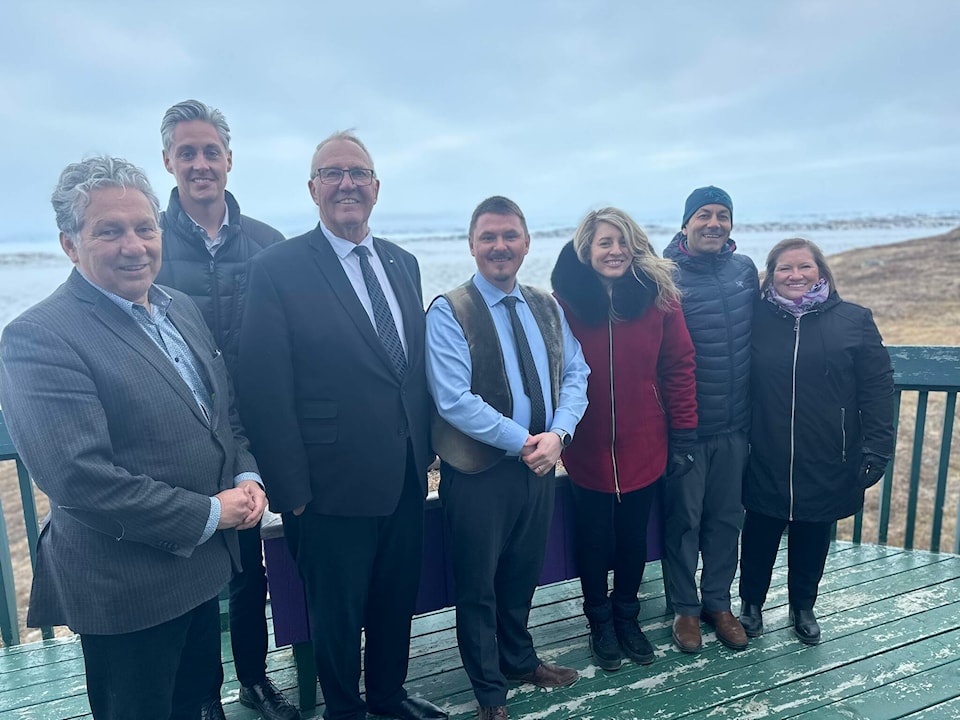The world has changed over the last two years. In the Arctic, it’s changing four times faster.
Words to these effect were echoed by all three federal ministers at the media roundtable discussion for Arctic and northern security in Iqaluit on the morning of May 6.
The federal trifecta, Defence Minister Bill Blair, Foreign Affairs Minister Mélanie Joly, and Northern Affairs Minister Dan Vandal had met with the three territorial premiers the previous day in Nunavut’s capital to discuss the new policies outlined in the federal government’s latest northern security document, Our North Strong and Free: A Renewed Vision for Canada’s Defence.
Partnership to create infrastructure in support Canada’s northern peoples
“We gave [the premiers] an update,” began Blair, “in a secure environment on Arctic security and northern security … We also discussed at some length about climate change and how it’s disproportionately affecting the Arctic, which is of course warming four times faster than the global average. That is making the Arctic far more accessible. We’re seeing much greater activity among our potential adversaries, particularly Russia and China, in the region. Our competitors are exploring the waters, probing our infrastructure and collecting intelligence.”
Blair emphasized during the media session that the use of the possessive first person plural, “our”, in the title of the new defence policy, Our North Strong and Free, had been a deliberate point of discussion by policy makers in Ottawa. The colonial approach the federal government has taken in the past when it comes to approaching Arctic sovereignty on Inuit lands has resulted in mistakes — but mistakes that will help all Canadians learn from the past and implement a better, united approach for the future, said the minister
“With the introduction of our new defence policy, from my perspective, but also [because of] a number of really important issues … We think it’s very critical that we closely engage with both territorial governments, as well as Northerners and local Indigenous communities. It is essential we hear directly from them on security and defence concerns … So that we can work together to protect the Arctic and northern communities and peoples here in Canada.”
Blair touched on the importance of food security in Canada’s North, but also emphasized the building and creation of five northern hubs, yet to be announced, over the next two decades that will create an enhanced northern infrastructure and line of defence for NATO’s western and northern flanks, as well as fulfilling Canada’s duties as the northern partner in NORAD.
The significant financial investments of the federal government include $218 million over 20 years for these “Northern Operational Support Hubs” that will establish a greater year-round military presence across the Arctic and the North, and invest in multi-use infrastructure that also meets the needs of territories, Indigenous peoples, and northern communities.
Military investments, to be parceled out over the next two decades, include: $18.4 billion for effective tactical helicopter capability, $307 million for airborne early warning aircraft; $1.4 billion over 20 years to acquire specialized maritime sensors; and $222 million to build a new satellite ground station.
Overall, the federal government is estimating Canada’s new defense spending to GDP ratio to reach 1.76 per cent in 2029-30, which would have Canada exceed NATO’s target of 20 per cent for major equipment expenditures as a proportion of defense funding.
Canada’s reality: a Russia-fronting country
From the foreign policy perspective, which is now inextricable from national defence policy, Joly was quick to assert just how much of a role increasing Russian aggression has informed this joint collaboration going forward between hers and Blair’s departments.
“More than ever, we are indeed a Russia-fronting country. A neighbour to Russia. We know that Russia and China are in the Arctic, and so we need to take stock of that. People in the south don’t necessarily appreciate as much as people in the North how much of this is just Canada’s reality.”
Becoming more accessible, becoming better protected
The reality we face in an increasingly unstable, violent, and uncertain geo-political climate is that the 150,000 Canadians, including the Indigenous populations of the North, are no longer protected by the geographical barriers of sea and ice.
Technological advancements and increasing foreign military aggression in the Asian and European arenas make Canada, bordered on three sides by oceans, now vulnerable.
By 2050, the Arctic Ocean could become the most efficient shipping route —- or the least protected naval frontier — between Europe and east Asia. Canada’s Northwest Passage and the broader Arctic region are already more accessible to foreign incursion, “and that brings all sorts of risks” commented Minister Vandal. “When we talk about sovereignty of the North, we talking really about empowering the people that live here, including Inuit, Indigenous, First Nations, and Metis. We’re talking about better housing, we’re talking about better infrastructure, dual use … that people who live here can enjoy and benefit from.
“We are turning our minds and investments towards that,” said Blair.
The Northern Policy Framework’s principle of “nothing about us, without us” means that no decisions are made about Arctic sovereignty without the direct consultation of northern peoples that come out of meetings such as this.
“Every conversation I’ve had with Northerners about Arctic sovereignty and about Arctic security,” summarizes Blair, “they’ve told me it’s really about infrastructure. It’s about highways and airports. It’s about fibre optics and water treatment plants, medical facilities and housing. It’s about building infrastructure in community and in capability. We think there’s a great opportunity for us to do that … It could create jobs, but it could also create infrastructure that will support Northern peoples. We believe that doing that together is the best way to get it done. We’re continuing to focus on consultation, collaboration, partnership. That is essentially why we’ve come here for this meeting … Engage in our perspectives, but also learn from theirs.”
